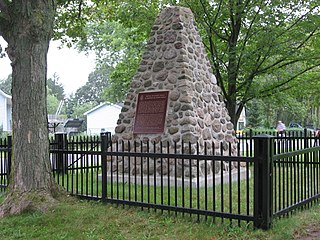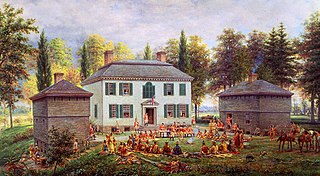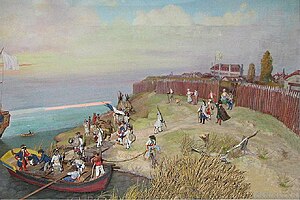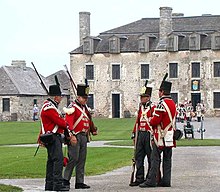
The Niagara River is a river that flows north from Lake Erie to Lake Ontario. It forms part of the border between the province of Ontario in Canada and the state of New York in the United States. There are differing theories as to the origin of the river's name. According to Iroquoian scholar Bruce Trigger, Niagara is derived from the name given to a branch of the locally residing native Neutral Confederacy, who are described as being called the Niagagarega people on several late-17th-century French maps of the area. According to George R. Stewart, it comes from the name of an Iroquois town called Ongniaahra, meaning "point of land cut in two".

The Battle of Lundy's Lane, also known as the Battle of Niagara, was fought on 25 July 1814, during the War of 1812, between an invading American army and a British and Canadian army near present-day Niagara Falls, Ontario. It was one of the bloodiest battles of the war, and one of the deadliest battles fought in Canada, with approximately 1,720 casualties including 258 killed.

Fort Mifflin, originally called Fort Island Battery and also known as Mud Island Fort, was commissioned in 1771 and sits on Mud Island on the Delaware River below Philadelphia, Pennsylvania near Philadelphia International Airport.

The Battle of Chippawa, also known as the Battle of Chippewa, was a victory for the United States Army in the War of 1812, during its invasion on July 5, 1814, of the British Empire's colony of Upper Canada along the Niagara River. This battle and the subsequent Battle of Lundy's Lane demonstrated that trained American troops could hold their own against British regulars. The battlefield is preserved as a National Historic Site of Canada.

The Battle of Fort George was a battle fought during the War of 1812, in which the Americans defeated a British force and captured Fort George in Upper Canada. The troops of the United States Army and vessels of the United States Navy cooperated in a very successful amphibious assault, although most of the opposing British force escaped encirclement.

Fort Wadsworth is a former United States military installation on Staten Island in New York City, situated on The Narrows which divide New York Bay into Upper and Lower halves, a natural point for defense of the Upper Bay and Manhattan beyond. Prior to closing in 1994 it claimed to be the longest continually garrisoned military installation in the United States. It comprises several fortifications, including Fort Tompkins and Battery Weed and was given its present name in 1865 to honor Brigadier General James Wadsworth, who had been killed in the Battle of the Wilderness during the Civil War. Fort Wadsworth is now part of the Staten Island Unit of Gateway National Recreation Area, maintained by the National Park Service.

The Battle of Cook's Mills was the last engagement between U.S. and British armies in the Niagara, and the penultimate engagement on Canadian soil during the War of 1812. After about a half-hour, American forces out-maneuvered the British column and destroyed all grain and flour.

The Capture of Fort Niagara took place late in 1813, during the War of 1812 between the United Kingdom and the United States. The American garrison was taken by surprise, and the fort was captured in a night assault by a select force of British regular infantry.

Gorgas Hospital was a U.S. Army hospital in Panama City, Panama, named for Army Surgeon General William C. Gorgas (1854–1920).

The Watervliet Arsenal (WVA) is an arsenal of the United States Army located in Watervliet, New York, on the west bank of the Hudson River. It is the oldest continuously active arsenal in the United States, and today produces much of the artillery for the army, as well as gun tubes for cannons, mortars, and tanks. It has been a National Historic Landmark (NHL) since 1966.

Fort Washington, located near the community of Fort Washington, Maryland, was for many decades the only defensive fort protecting Washington, D.C. The original fort, overlooking the Potomac River, was completed in 1809, and was begun as Fort Warburton, but renamed in 1808. During the War of 1812, the fort was destroyed by its own garrison during a British advance.

Fort Tilden, also known as Fort Tilden Historic District, is a former United States Army installation on the coast in the New York City borough of Queens. Fort Tilden now forms part of the Gateway National Recreation Area, and is administered by the National Park Service.

The Crailo State Historic Site is a historic, fortified brick manor house in Rensselaer, New York which was built in 1707. The word Crailo is derived from kraaien bos and refers to Kiliaen van Rensselaer's estate in Huizen, Holland, which is also named "Crailo". Fort Crailo is listed on the National Register of Historic Places.

Johnson Hall State Historic Site was the home of Sir William Johnson (1715–1774) an Irish pioneer who became the influential British Superintendent of Indian Affairs in the Province of New York, known for his strong relationship especially with the Mohawk and other Iroquois League nations.

Marine Corps Air Station Kaneohe Bay or MCAS Kaneohe Bay is a United States Marine Corps (USMC) airfield located within the Marine Corps Base Hawaii complex, formerly known as Marine Corps Air Facility (MCAF) Kaneohe Bay or Naval Air Station (NAS) Kaneohe Bay. It is located two miles northeast of the central business district of Kaneohe, in Honolulu County, Hawaii, United States. The airfield has one runway (4/22) with a 7,771 x 200 ft asphalt surface.

Fort Jefferson is a former U.S. military coastal fortress in the Dry Tortugas National Park of Florida. It is the largest brick masonry structure in the Americas, covering 16 acres (6.5 ha) and made with over 16 million bricks. Among United States forts, only Fort Monroe in Virginia and Fort Adams in Rhode Island are larger. The fort is located on Garden Key in the lower Florida Keys within the Dry Tortugas, 68 miles (109 km) west of the island of Key West. The Dry Tortugas are part of Monroe County in Florida.

Whitney Mansion is a historic home located at Niagara Falls in Niagara County, New York. It is a two-story Greek Revival stone structure built in 1849 by the son of General Parkhurst Whitney, a village founder and owner of the Cataract House and The Eagle Tavern. The structure features a two-story pedimented porch with four heavy Ionic columns. It is located overlooking the Niagara River, just above the American Falls. It now contains law offices.

Lowertown Historic District is a national historic district located at Lockport in Niagara County, New York. The district is predominantly residential in nature, with some commercial structures and warehouses. The mose elegant homes are along Market Street, east of Chapel Street, facing the Erie Canal. Notable structures in this district include the Western Block Company Warehouse, a 2+1⁄2-story stone structure built before 1855; Lockport Bank Building built in 1829, and located at 315-319 Market Street; Washington Hunt House, built in 1831 and home to New York Governor Washington Hunt, and located at 363 Market Street; the former Christ Episcopal Church at 425 Market Street; and the Vine Street School, an Italianate style one-room school built in 1864.

Fort Kamehameha was a United States Army military base that was the site of several coastal artillery batteries to defend Pearl Harbor starting in 1907 in Honolulu, Hawaii.
Twenty-three currently active battalions of the Regular Army earned credit for campaigns during the War of 1812: two Air Defense Artillery battalions, six Field Artillery Battalions and seventeen Infantry battalions. These twenty-three battalions represent two Air Defense Artillery, four Field Artillery and seven Infantry regiments. Three additional Air Defense Artillery regiments have been awarded shared credit for War of 1812 campaigns, but the lineages of the artillery companies that earned those credits have not been perpetuated by currently active battalions.


![Overlooking Fort Niagara, [ca. 1915] Overlooking Fort Niagara (I0004210).jpg](http://upload.wikimedia.org/wikipedia/commons/thumb/7/7c/Overlooking_Fort_Niagara_%28I0004210%29.jpg/220px-Overlooking_Fort_Niagara_%28I0004210%29.jpg)




























